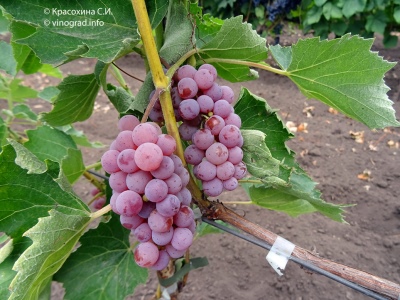
- Authors: Elmer Swenson, USA
- Berry color: pink
- Taste: pleasant, harmonious
- With bones: No
- Ripening period: very early
- Frost resistance, ° C: -34
- Flower type: bisexual
- Appeared when crossing: E. S. 5-3-64 x Petit jewel
- Berry shape: rounded
- The power of growth: medium-sized
The Somerset Siddles grape is widely distributed due to its tasty and juicy fruits. The berries can be eaten fresh or used to make drinks.
Breeding history
This variety came about through a complex breeding process. US specialist Elmer Swenson created a new species by crossing different types of horticultural crops. The Somerset Siddles grape has absorbed all the positive characteristics of the parent plants. The result is a variety with high aesthetic and gastronomic qualities.
Description
Strong bushes need strong supporting structures. Experienced gardeners recommend using trellis systems. When forming a plant, you can choose any of the options: make the bush low or high. The vine of this variety is long and thin. The bunches cover it evenly along its entire length.
Ripening period
This grape variety has a very early ripening period. The first fruits under favorable weather conditions can be harvested in the last month of summer or early autumn.
Bunches
The average weight of the bunches is about 200 grams. Most often, the weight varies from 180 to 450 grams. The fruits are medium-sized, neat. Medium to high density. The most common is the conical shape.
Berries
Ripe berries acquire a rich pink color. Round-shaped fruits have no seeds. The sizes are small even under favorable growing conditions. The weight of one berry is about 2 grams. The juicy pulp is covered with a dense skin that is not felt when eaten.
Taste
Experts describe the taste of the fruit as pleasant and harmonious. In the aftertaste, you can find notes of strawberries. Separately, it is worth noting the mouth-watering aroma that attracts birds and insects. The sugar content is over 20%. Due to their high gastronomic qualities, the fruits are often eaten fresh.
Yield
The Somerset Siddles grape yield is average, but with proper care of the plant, the berries can be harvested regularly. During the season, from one bush is collected from 5 to 8 kilograms.


Growing features
Due to its high frost resistance, this fruit crop variety is ideal for northern regions with harsh winters. You also need to periodically prune so that the fruits are as large as possible, and the plant feels comfortable.
One of the rules of competent cultivation is the correct implementation of ringing. The procedure will make the berries larger and speed up the formation of ovaries.
Landing
Lighted areas are great for planting. Grapes are not particularly whimsical to the composition of the soil, but it is best to choose a fertile soil. When choosing seedlings, carefully examine them for diseases and damage. Plant only healthy plants.

Pollination
During the flowering period, the grapes are covered with bisexual flowers. This feature allows him to pollinate on his own.
Pruning
Experts offer a choice of two molding options: low or high. Formative pruning is only necessary when the vines are overloaded or if the fruits are unevenly distributed on the branches. Due to the dynamic growth, the bushes are able to withstand heavy loads without problems. Trimming is performed for 5-10 eyes, no more. Professional gardeners advise leaving 45 eyes on the grapes.
You also need to pay attention to the foliage. It is thinned periodically to provide the plant with the necessary oxygen circulation. Bulky green mass can block the fruits from the sun's rays, which will prevent them from ripening properly. During the growing season, excess shoots are removed from the sinuses. Work is being done to reduce the overall load on the bush. This procedure has a positive effect on the size of the bunches.



Frost resistance and the need for shelter
The variety can withstand temperatures up to 34 degrees below zero. This characteristic allows not to cover the culture for the winter, especially if the vineyards are located in the southern part of the country. If necessary, you can protect the cuttings with a light cover.

Diseases and pests
The Somerset Siddles grape has a strong innate immunity that will protect the plant from fungal infections. Also, the plant is not afraid of mildew (a common and dangerous disease). The plant shows high resistance to gray mold, powdery mildew and other infections. Despite these characteristics, it is advisable to periodically inspect the vine for disease. Damaged shoots are removed immediately.

If a grape is exposed to any disease or insect, this always affects its appearance.
Storage
Ripe fruits are remarkably preserved on the bushes, the peel remains intact. The crop is highly transportable due to its dense skin. The collected berries are stored in wooden boxes.











































































